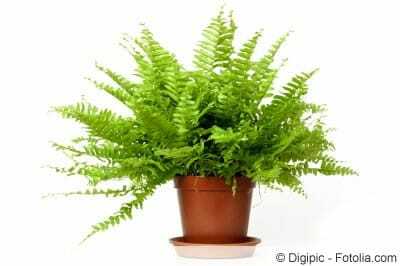

Table of contents
- Characteristics
- species
- Location
- substrate
- repot
- Pour
- Fertilize
- Cut
- hibernate
- multiply
- pests
As a houseplant, fern is one of the easy-care plants. The low cost and decorative value explains the popularity of primeval plants. Room fern care is explained in detail in this guide.
Characteristics
- Plant Group: Ferns
- includes numerous species
- Classes: True ferns (Polypodiopsida), Psilotopsida, Equisetopsida, Marattiopsida)
- all species are monophyletic
- Distribution: worldwide
- Growth form: upright, bushy, overhanging, deciduous, evergreen, rarely as a tree or palm
- Growth height: 10 cm to 3,000 cm
- forms spore capsules on the underside of the leaf
- Leaves: Fronds of species-dependent sizes, various shades of green, pinnate
- entire group poisonous
species
Of the over 12,000 species of ferns in the world, a small number are ideal for permanent indoor cultivation. Room ferns do not differ in any way from their relatives, they can only be kept in the house without any problems because of their growth characteristics and needs. The following list gives you an overview of suitable species that you can keep as indoor ferns:
- maidenhair fern (Adiantum raddianum)
- antler fern (Platycerium bifurcatum)
- goldenspotted fern (Phlebodium aureum)
- Hare's Foot Fern, Hare's Foot Fern (Davallia bullata)
- Japanese sago cycad (Cycas revoluta)
- nest fern (Asplenium nidus)
- pellet fern (Pellaea rotundifolia)
- rib fern (Struthiopteris spicant)
- sword fern (Nephrolepis exaltata)
Location

One of the most important points about caring for an indoor fern is location. Ferns do not need extensive care if you give them a suitable place in the home. When choosing the location, pay attention to the following characteristics:
- Light requirement: bright, shady to semi-shady
- avoid direct sun
- avoid shady corners
- Minimum temperature: 12°C
- Avoid drafts
Tip:
Due to the higher humidity, bathrooms are particularly suitable for the plants. However, the bathroom should have a window, otherwise it will be too dark for you.
substrate
In addition to the selected place in your living space, you need to choose a suitable substrate. Basically, you can use the same substrate for all indoor ferns, which gives you enough freedom in choosing the species. The following properties are important:
- high quality potting soil
- permeable
- humorous
- slightly damp
- low in lime
A notice:
Some types of ferns, such as the rabbit foot fern, do not require a substrate because they are epiphytes. All you need for this is a large, porous rock for the fern to cling to.
repot
In order to maintain the growth and vitality of an indoor fern, the plant must be repotted at regular intervals. Over time, the vessel becomes too small for them, the soil compacts or becomes too lean. To avoid this problem, you need to repot at the right time. Repotting takes place directly after winter in the period from February to March. You should not repot later, as the ferns will sprout again. The frequency is just as important, because depending on the age and growth form of the ferns, you have to observe a different rhythm:
- young specimens: every 1 to 2 years
- older specimens: every 4 years
- Ferns in tree or palm form: 5 to 6 years
- Roots grow from pot drainage holes
The houseplant does best in pots that are not too deep. The flat-rooted plant does not require much space, but will root through the substrate over time.

Once it's time to repot, you can use the guide below as a guide:
- choose a slightly larger pot
- should have drainage holes
- Remove plant from old pot
- Remove soil from roots
- remove dead, dried up or rotten roots
- Also remove dried or brownish fronds
- Create a drainage layer on the bottom of the pot
- Drainage material: expanded clay, potsherds, gravel
- fill a third of the pot with substrate
- Insert plant straight
- fill up
- press carefully
- water well
A notice:
You can easily cultivate many species in a hanging basket. This method is particularly suitable if you do not have enough space for real buckets.
Pour
An essential point in the care of indoor ferns is the ample supply of water. The plants are dependent on large amounts of water, but must never be exposed to waterlogging. Stagnant moisture leads to root rot, which can be deadly for houseplants. For this reason, you should only water as needed. You can do this by regularly checking the top layer of soil for dryness. When completely dry, water. Make sure that you only use water that is low in lime, for example filtered or rainwater.
Tip:
A freshness kick for the indoor fern is an interim spray mist. Fill a spray bottle with suitable water and spray the plant generously.
Fertilize
As such, indoor ferns do not require any additional nutrients if they have been repotted at the right time and a suitable substrate is used. If you still recognize deficiency symptoms such as hanging or pale fronds, you can also administer fertilizer. This is possible from spring to autumn, because the ferns do not sprout further over the winter and therefore do not need any nutrients. To fertilize, use a classic flower or potted plant fertilizer, which is administered as follows:
- every 2 weeks
- administer via irrigation water
- Use half the recommended dosage
- alternatively fertilize with milk in the same way
Cut
Ferns don't really need pruning unless they are deciduous species. In this case, pruning before winter is necessary. This can be recognized by the color of the leaves, because the closer winter comes, the more brown the fronds turn. Brown fronds are always a sign of dried plant parts that the fern no longer needs and can safely be cut off. If you can no longer cut the houseplant in autumn, move the appointment to spring. You just have to be careful not to damage new fronds. The cut works as follows:
- put on gloves
- Ferns are poisonous
- use disinfected, sharp scissors
- Cut back deciduous species completely
- all fronds down to the ground
- thin out evergreen species
- only remove brown fronds
hibernate
Winter is a big problem for houseplants, as they cannot tolerate temperatures below 12°C. Fortunately, the annual location is just as well suited for overwintering. The only problem can be prolonged drought when the heating is on over the winter. Dry heating air ensures that your room fern loses moisture more quickly. To prevent this problem, you need to check the substrate for moisture more often. It is also advisable to spray the fern with water more frequently than usual so that the fronds do not dry out. Sufficient moisture protects against typical drought pests such as spider mites.

multiply
Because ferns evolve via their spores in the wild, if you want more specimens, you'll have to take action yourself. Propagation via spores is theoretically possible, but can take one to two years. For this reason, indoor ferns can best be propagated by dividing the root ball. Since house ferns are extremely hardy, this method poses no threat to them and the whole process goes without major problems. Alternatively, you could use cuttings, but not all indoor ferns produce them. The division is ideally carried out during repotting, since you have to put the root pieces in fresh substrate afterwards anyway:
- Remove the fern from the planter
- use a sharpened and disinfected knife
- Remove soil from roots
- Divide the root ball in the middle
- alternatively cut into several parts
- possible with larger ferns
- Place sections in individual pots
- maintain as usual
pests
Pests are not really a problem for the fern itself. Only intense drought can lead to a pest infestation, as this significantly weakens the room fern. The most common pests throughout the year include:
- spider mites
- aphids
- scale insects
For this reason, check your ferns for pests after an unwanted dry period. You can recognize spider mites, for example, by the webs between the fronds, while aphids and scale insects are quite easy to spot. Since indoor ferns can be nursed back to health quickly, use the same approach to control all three pests:
- Do not cut off affected fronds
- unless they are brown
- Rinse the plant thoroughly
- repot when infested
- Replace earth completely
- check roots
- remove dead ones
- then increase the humidity in the room
 garden editorial
garden editorial I write about everything that interests me in my garden.
Learn more about Ferns & Mosses

Fern in the garden: 9 tips for care and pruning
Ferns are not only popular indoor plants, they also do very well in the home garden. In this article you will find out what needs to be considered when caring for the plants!

Maidenhair Fern, Adiantum: care from A to Z
Maidenhair fern species are decorative and graceful throughout the year in the house or conservatory. Ferns have become increasingly popular, at least since the Pete specimen at London Zoo, which was the first plant to take selfies. However, maintenance requires a great deal of effort.

Sword fern, Nephrolepis - varieties and care
Sword ferns are impressive plants that originate from the tropics. In this country you can find them as impressive indoor plants, with their long, feathered shoots. The light green leaves are on long stalks that can reach a length of up to one meter. The sword fern is relatively demanding in terms of care, although other ferns can do better. The choice of location is particularly important for Nephrolepis exaltata and cordifolia. This should be bright, warm and humid. The bathroom is ideal. Here the humidity is high enough to provide the plant with moisture from the outside...

Care of ferns - location, planting and propagating
True ferns, known to most simply as ferns, come in several species. What they all have in common is the shape of the leaves, called fronds, and the fact that the fern can usually be grown both indoors and outdoors.

Tansy, Tanacetum vulgare - profile, plants & care
Anyone who has ever been out and about in the forest or on natural meadows has certainly seen tansy. It likes to grow on paths, forest edges and fallow land. The plant, also known as wormwood, can be recognized by its umbel-like flower heads without marginal flowers in bright yellow and by its smell. The plant contains essential oils and bitter substances. The smell (camphor-like) is not perceived as very pleasant by many.

Male ferns, Dryopteris - profile and varieties
The true male fern is the most common representative of the male ferns in Central Europe. It needs a semi-shady location and humus-rich soil. The real male fern is hardy. Its fronds reach a length of 1 to 1.5 meters. With the right location and sufficient moisture, this fern is easy to care for and undemanding.
